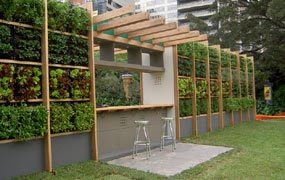

:: image via Not a Cornfield
"Not A Cornfield is a living sculpture in the form of a field of corn. The corn itself, a powerful icon for millennia over large parts of Central America and beyond, can serve as a potent metaphor for those of us living in this unique megalopolis. This work follows a rich legacy of radical art during the 20th century on a grand scale. I intend this to be an event that aims at giving focus for reflection and action in a city unclear about where it's energetic and historical center is. With this project I have undertaken to clean 32 acres of brownfield and bring in more than 1,500 truck loads of earth from elsewhere in order to prepare this rocky and mixed terrain for the planting of a million seeds. This art piece redeems a lost fertile ground, transforming what was left from the industrial era into a renewed space for the public. ... By bringing attention to this site throughout the Not A Cornfield process we will also bring forth many questions about the nature of urban public space, about historical parks in a city so young and yet so diverse. About the questions of whose history would a historical park in the city center actually describe, and about the politics of land use and it's incumbent inequities. Indeed, "Not A Cornfield" is about these very questions, polemics, arguments and discoveries. It is about redemption and hope. It is about the fallibility of words to create productive change. Artists need to create on the same scale that society has the capacity to destroy.”
These ephemeral installations are great opportunities to both occupy blighted lands as well as the ability to reconnect residents to their agricultural pasts. A Portland project endeavoring to identify urban agriculture opportunities is the Diggable City, which identified available lands within the city for production. As I have mentioned previously, the opportunities to occupy available lands in urban areas for agriculture (on land, rooftop, and perhaps even facade) is a great multi-functional chance to provide self-sufficiency and interpretation.
As far as buzz goes, the terminology zipping around the, for lack of a better pun, crop circles - includes a number of new members of the agri-lexicon. One of my favorites is locavore, and a variant, the "100-mile diet" were recently profiled on Treehugger in a great post: "Green Basics: Local Food"

:: image via Treehugger
The post is worth a close read, and also has links to a number of local food resources. While we often use these terms, it's good to re-evaluate the ecological values embodied in the concept. The article adds: "The concept is also defined in terms of ecology, where food production is considered from the perspective of a basic ecological unit defined by its climate, soil, watershed, species and local agrisystems; everything together is defined as as "ecoregion" or "foodshed."
Ah, a couple of other terms, one that is getting much use is "foodshed". A new term, right? Well, not exactly. Adapted from the ecological concept of watershed, the term was coined in 1929 to: "...describe the flow of food from the area where it is grown into the place where it is consumed." (via Wisconsin Foodshed Research Project). The exact radius varies for the distance of acceptable food miles traveled, but just for kicks, strike a 100 mile circle around your house, and consume from just this area. Now do this in Houston - or Phoenix - or Fargo. It is possible, but not necessarily easy.

:: image via Treehugger
Another term that was pointed out to me in a comment to previous post involving the significant carbon sequestration potential in soils. The latest term picked up recently by Treehugger, involves biochar (aka agrichar, terra preta) not just for Simply put it is: "...what you get when biomass is heated in the absence of oxygen through a process called pyrolysis. When incorporated into soil, biochar provides the structural habitat needed for a rich community of micro-organisms to take hold. Incorporating biochar into soil can also act as a way to sequester carbon."
What's the big deal? Again, multi-functional solutions. (via Treehugger): "Biochar is a classic win-win scenario, a solution that can provide us with a valuable tool for fighting climate change, world hunger, poverty, and energy shortages all at the same time." A number of new initiatives are capitalizing on the phenomenon, including the International Biochar Initiative and the Biochar Fund, both with some great additional resources.
Finally, let's marry a couple of buzz-concepts - urban agriculture and vertical greening. A different scale than some of the featured rooftop ag gardens, this project preceded a multi-part post on My Urban Garden Deco Guide and the companion site 'My Urban Farm' as blogger Anne Robert bemoans the lack of aesthetics in the new wave of planters focussed around Grow Your Own veggies as new urban trend. One exception is a previous post on 'Salad Bar' which provides a new vision for facade-grown veggies in a more refined container.
:: image via My Urban Garden Deco Guide
:: image via Turf Design
Now that is tasty!



No comments:
Post a Comment